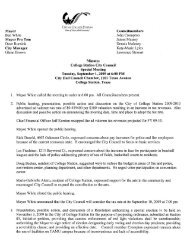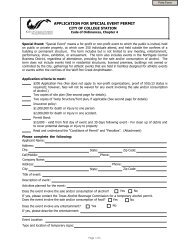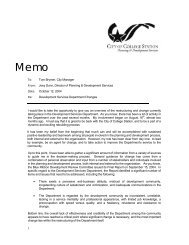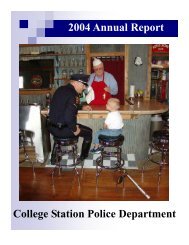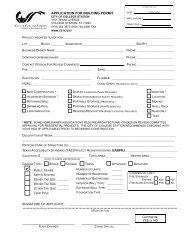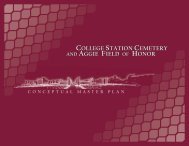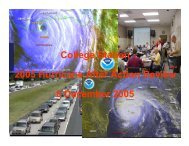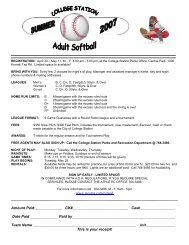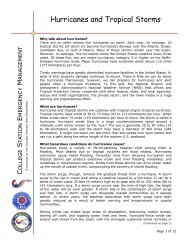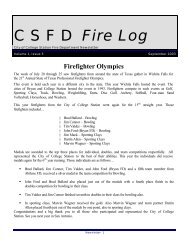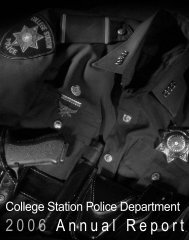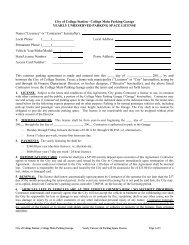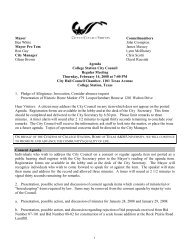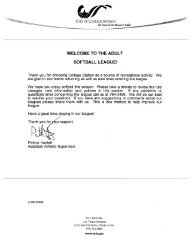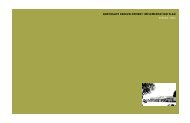standard operating procedure college station fire department
standard operating procedure college station fire department
standard operating procedure college station fire department
Create successful ePaper yourself
Turn your PDF publications into a flip-book with our unique Google optimized e-Paper software.
SUBJECT: Personal Protective Equipment SOP: 300.2.10<br />
CATEGORY: Use, Inspection, Maintenance, Cleaning, Repair and/or Replacement PAGE: 2 of 8<br />
PROCEDURES cont.<br />
♦ Aircraft Emergencies and Standbys<br />
♦ Major Vehicle Accidents (excluding SCBA and Hood)<br />
Full Protective Clothing is not required when responding to Medical Assist Calls.<br />
Company Officers may use their discretion to regulate these guidelines in terms of unusual<br />
circumstances, such as extremely long responses, out of quarters responses or when the company<br />
is rolling at the time of dispatch.<br />
Any person riding in the jump seat of any open cab apparatus is required to wear a protective<br />
helmet and hearing protection. Wearing a helmet is optional for personnel riding in an enclosed<br />
cab.<br />
Hearing protection will be worn when excessive noise levels may be experienced, regardless of<br />
the length of exposure.<br />
EXAMPLES include, but are not limited to the following situations:<br />
♦ Code three responses in open cab apparatus<br />
♦ When riding in jump seats of open cab apparatus<br />
♦ When checking apparatus in the bay<br />
♦ When <strong>operating</strong> at the pump panel of <strong>fire</strong> apparatus<br />
♦ When <strong>operating</strong> the air compressor<br />
Eye Protection will be worn whenever the possibility of eye injury is present.<br />
EXAMPLES include, but are not limited to the following situations:<br />
♦ Working with any small hand or power tools, such as saws, sanders, grinders, rescue tools,<br />
etc.<br />
♦ Operating the air compressor<br />
♦ Working at the scene of major accidents (when helmet face shield is not in use)<br />
♦ Working with chemicals, biohazards or other materials which could cause injury by<br />
splattering/spilling<br />
♦ Performing salvage operations (when helmet face shield is not in use)<br />
The Incident Commander will designate the acceptable level of personnel protection while<br />
<strong>operating</strong> at the scene of a vehicle extrication, rescue call, standby, or other unusual response<br />
situation.<br />
When actively involved in training drills and hose or hydrant testing the following shall be the<br />
minimum protective equipment used by each person:<br />
♦ Helmet<br />
♦ Safety Glasses or Lowered Face Shield<br />
♦ Gloves<br />
Dependent on the activity, the officer in charge or his delegate may require additional personal<br />
protective equipment to be used.<br />
rev:4/94, 8/95, 3/99, 12/00, re#d 11/02



